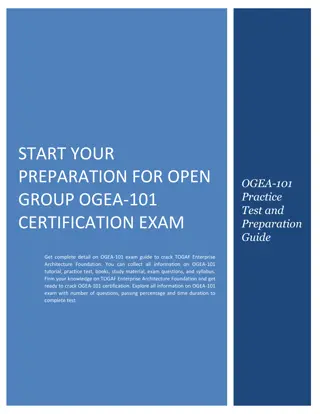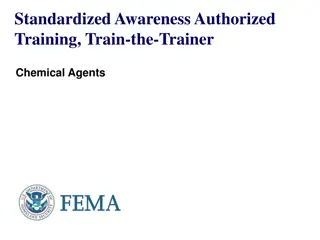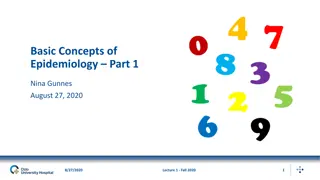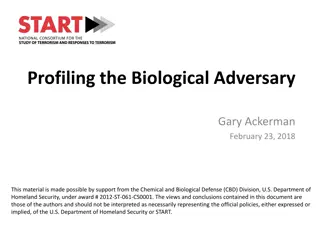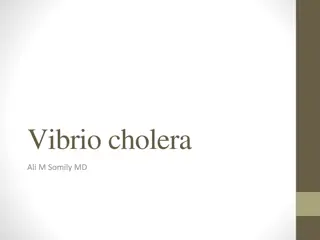Biological Threat Agents 101: Epidemiology, Clinical Features, and Management
Know the epidemiology, contagiousness, and ease of dissemination of biological threat agents. Identify clinical features, understand management, treatment, and prevention. Learn about critical biological agents like Anthrax, Plague, and Smallpox.
Download Presentation

Please find below an Image/Link to download the presentation.
The content on the website is provided AS IS for your information and personal use only. It may not be sold, licensed, or shared on other websites without obtaining consent from the author.If you encounter any issues during the download, it is possible that the publisher has removed the file from their server.
You are allowed to download the files provided on this website for personal or commercial use, subject to the condition that they are used lawfully. All files are the property of their respective owners.
The content on the website is provided AS IS for your information and personal use only. It may not be sold, licensed, or shared on other websites without obtaining consent from the author.
E N D
Presentation Transcript
Biological Threat Agents 101 Robert J. Leggiadro, MD Villanova University Cohen Children s Medical Center of NY Donald and Barbara Zucker School of Medicine at Hofstra/Northwell ACHA Annual Meeting Washington, DC May 30, 2018
Disclosures Dr. Leggiadro was a full-time employee of Pfizer and Merck
Learning Objectives Know the epidemiology, including contagiousness and ease of dissemination, of the more credible biological threat agents. Identify clinical features of the more credible biological threat agents, including recognition of unusual clinical syndromes or increases above seasonal levels in the incidence of common syndromes or deaths from infectious agents. Understand management, including reporting, treatment and prevention, of the more credible biological threat agents.
Clinical and Epidemiological Clues to a BTA Attack Abrupt onset\Large number of cases Point-source outbreak Occurrence of non-endemic disease Disease occurring out of season Unusual clinical presentations No obvious epi risk factors
Critical Biological Agents Bacteria Anthrax Plague Tularemia Viruses Smallpox Viral hemorrhagic fever Toxins Botulinum toxin
Anthrax Bacillus anthracis, a bacterial zoonosis Anthrakis, from the Greek word for coal Cutaneous, inhalational, GI and injectional clinical forms Cutaneous most common 20 animal contact No human-human transmission
Sverdlovsk Incident at a military microbiology facility Former Soviet Union, 1979 Grim warning of biologic weapons dangers Accidental release anthrax spores At least 79 cases, including 68 deaths Largest reported inhalational outbreak, occurred within 4 km zone downwind
Investigation of Bioterrorism-related Anthrax and Interim Guidelines for Clinical Evaluation of Persons with Possible Anthrax CDC. MMWR 2001; 50: 94-8.
Investigation of Bioterrorism-related Anthrax and Interim Guidelines for Clinical Evaluation of Persons with Possible Anthrax CDC MMWR 2001; 50: 94-8.
Anthrax Mediastinal Widening Jernigan JA et al. Emerg Infect Dis 2001; 7:933-44.
Anthrax Pneumonia Jernigan JA et al. Emerg Infect Dis 2001; 7:933-44.
Anthrax Meningitis Gram stain of cerebrospinal fluid showing B. anthracis. Jernigan JA et al. Emerg Infect Dis 2001; 7:933-44.
Inhalational Anthrax Management Ciprofloxacin and 1 additional antibiotic e.g. linezolid or clindamycin Cipro, meropenem and linezolid if meningitis has not been ruled out
Anthrax Raxibacumab humanized monoclonal antibody directed against protective antigen, a component of the anthrax toxin. Approved for use together with antibiotics to treat anthrax with systemic illness. Anthrax Immune Globulin (AIG) CDC IND Either AIG or raxibacumab antitoxin is indicated in cases of systemic anthrax.
Inhalational Anthrax Post-exposure Prophylaxis Antibiotics Ciprofloxacin Doxycycline Amoxicillin Vaccination Anthrax vaccine adsorbed (AVA) Inactivated, cell-free product, 3 doses
Cutaneous Anthrax Blisters or small bumps may itch Swelling can occur around sore Painless ulcer with black center later (eschar) Face, neck, arms, hands www.cdc.gov/anthrax
Smallpox First used as biological weapon over 200 years ago British troops infected Native Americans through contaminated blankets
Smallpox Responsible for more deaths than any other infectious disease. 18th century Europe; 400,000 deaths/yr, including peasants and monarchs alike. 20th century alone; 1/2 billion deaths. 1949; last case in U.S. (Texas) Routine immunization in U.S. ended in 1972 Target date for destruction of known virus stock deferred
Smallpox: Potential Significance WHO declared eradication in 1980 Known viral stocks in only 2 labs: U.S. and Russia ? Clandestine stockpiles of virus Increasing number of susceptibles Stable virus, aerosol infectivity, human-human transmission, high mortality
Diagnosis of Smallpox Requires astute diagnostician to distinguish from varicella or erythema multiforme Tissue culture, variola-specific PCR assay and serologic tests will be performed at CDC reference laboratory
Smallpox Lesions on each area at same stage of development; deeply embedded; concentrated on face, extremities. Henderson DA. Emerg Infect Dis 1999; 5: 537-9.
Chickenpox Series of crops; superficial; trunk. Henderson DA. Emerg Infect Dis 1999; 5: 537-9.
Smallpox: Medical Management Even one confirmed case is an international public health emergency with immediate reporting to public health authorities Strict isolation with both respiratory and wound isolation No proven effective antiviral therapy
New York City Residents Line Up for Vaccinations During a Smallpox Vaccination Campaign, 1947. CDC. MMWR 2003; 52: 933-6.
Smallpox: Preventive Measures Vaccination: vaccinia live virus vaccine - Protection decreases with time - Contraindicated if pregnant or immunosuppressed All contacts should be STRICTLY quarantined for 16 -17 d post-exposure
Smallpox Vaccines Do not contain variola virus Made from related vaccinia virus FDA licensed new smallpox vaccine, grown in lab cell culture, ACAM2000 in 2007, which replaced previously licensed vaccine Dryvax Two additional smallpox vaccines in the Strategic National Stockpile are: WetVax and Imvamune
Smallpox Vaccines WetVax liquid formulation live vaccinia virus similar to lyophilized vaccine, Dryvax ACAM2000 and WetVax by scarification (percutaneous, bifurcated needle) Imvamune 3rd-generation, non-replicating smallpox vaccine for healthy persons AND persons with immunocompromising or pre-existing conditions, e.g., atopic dermatitis (subcutaneous injection)
Dermatologic Vaccinia Reactions Progressive vaccinia: Necrosis in the area of vaccinia Eczema vaccinatum: Local or generalized spread of vaccinia virus in eczema Generalized vaccinia: Skin lesions remote from the vaccination site Adalja AA et al. N Engl J Med 2015; 372: 954-62
Household Transmission of Vaccinia Virus from Contact with a Military Smallpox Vaccinee IL and IN, 2007 CDC. MMWR 2007; 56: 478-81
Smallpox Vaccination and Adverse Reactions CDC. MMWR 2003; 52(RR04): 1-28
Ring Around the Rosie: Plague Reference Ring around the rosie (rosy rash of plague) A pocket full of posies (herbs to ward off smell of the dead) Ashes! ashes! (cremation and burning victims houses) We all fall down (die)
Plague Zoonotic illness (Yersinia pestis) First used as biological weapon in the 14th century Tatar force attacking Caffa (Ukraine) Catapulted bodies of plague victims into the city
Plague Primarily disease of rodents Transmission to humans: flea bites, direct contact infected body fluids or tissues, or inhalation respiratory droplets (human-human transmission) 1-17 average # cases reported in the U.S. between 2001-2012; median # , 3 Arizona, California, Colorado, New Mexico Bubonic, septicemic, pneumonic clinical forms
Epidemiology of Human Plague in the U.S. Multiple rodents contribute to the current ecology of plague in the U.S., including: Ground squirrels Prairie dogs Wood rats Chipmunks Deer mice Voles
Reported Cases of Human Plague United States, 1970--2016 www.cdc.gov/plague
Human Plague Cases and Deaths United States, 2000-2016 www.cdc.gov/plague
Reported Plague Cases by Country, 2010-2015 www.cdc.gov/plague
Plague: Potential Significance Could be delivered as aerosol during a biological attack Has been studied as potential weapon by both Japan (WWII) and United States (1950s)
Pneumonic Plague: Clinical Features Incubation period of 2-3 days Initial symptoms are nonspecific: fever, chills, headache, cough Later progresses to respiratory failure and shock Human-to-human transmission
Diagnosis of Plague Gram\Wright-Giemsa\Wayson stain: - Gram negative coccobacillus - Bipolar safety-pin staining Pinpoint, grayish, slightly mucoid colonies after 24 hours on culture Confirmatory testing at CDC s reference laboratory (DFA, PCR)
Plague Management Streptomycin, gentamicin Doxycycline, ciprofloxacin Post-exposure Prophylaxis Doxycycline, ciprofloxacin Pre-exposure Prophylaxis Killed, whole-cell vaccine no longer available Droplet precautions for pneumonic plague
Tularemia Infection with Francisella tularensis Zoonosis Infectious dose is very low No human-human transmission Several forms reflect portal of entry: ulceroglandular, glandular, pneumonia, oropharyngeal, oculoglandular, typhoidal and gastrointestinal
Tularemia U.S., 2001-2010 1,208 cases (mean, 126 cases/yr; range, 90-154) Cases were reported from 47 states MO, AR, OK, MA, SD, KS; 59% cases 77% cases occurred May through September Peak arthropod activity/outdoor human activity Most common males, young and old
Tularemia Transmission Arthropod bites (Summer) Animal contact (Winter) Aerosolization (Lawn mowing) Contaminated water (Europe)
Reported cases of tularemiaUnited States, 2001-2010 Tularemia United States, 2001-2010. CDC. MMWR 2013; 62: 963-6.
Average incidence of tularemia, by age group and sex United States, 2001-2010 Tularemia United States, 2001-2010. CDC. MMWR 2013; 62: 963-6.
Geographic distribution of reported tularemia cases CO, NE, SD, and WY, January-September, 2015 Pedati C, et al. Increase in Human Cases of Tularemia CO, NE, SD, and WY, June-September, 2015. CDC. MMWR 2015; 64:1317-8.
Tularemia, U.S.- September, 2015 About 125 cases reported annually over the past 20 years As of 9/30/15, 100 cases reported from CO (43), NE (21), SD (20), and WY (16) Substantial increase in annual mean # of cases reported in each state during 2004-2014
Tularemia, U.S.-- 9/30/15 Possible reported exposure routes: Animal contact n=51 Environmental aerosolizing activities n=49 Arthropod bites n=34 41 patients reported 2 or more exposures
Tularemia, U.S.--9/30/15 Cause for the increases in 4 states unclear Possible explanations include: Increased rainfall promoting vegetation Pathogen survival Increased rodent and rabbit populations




